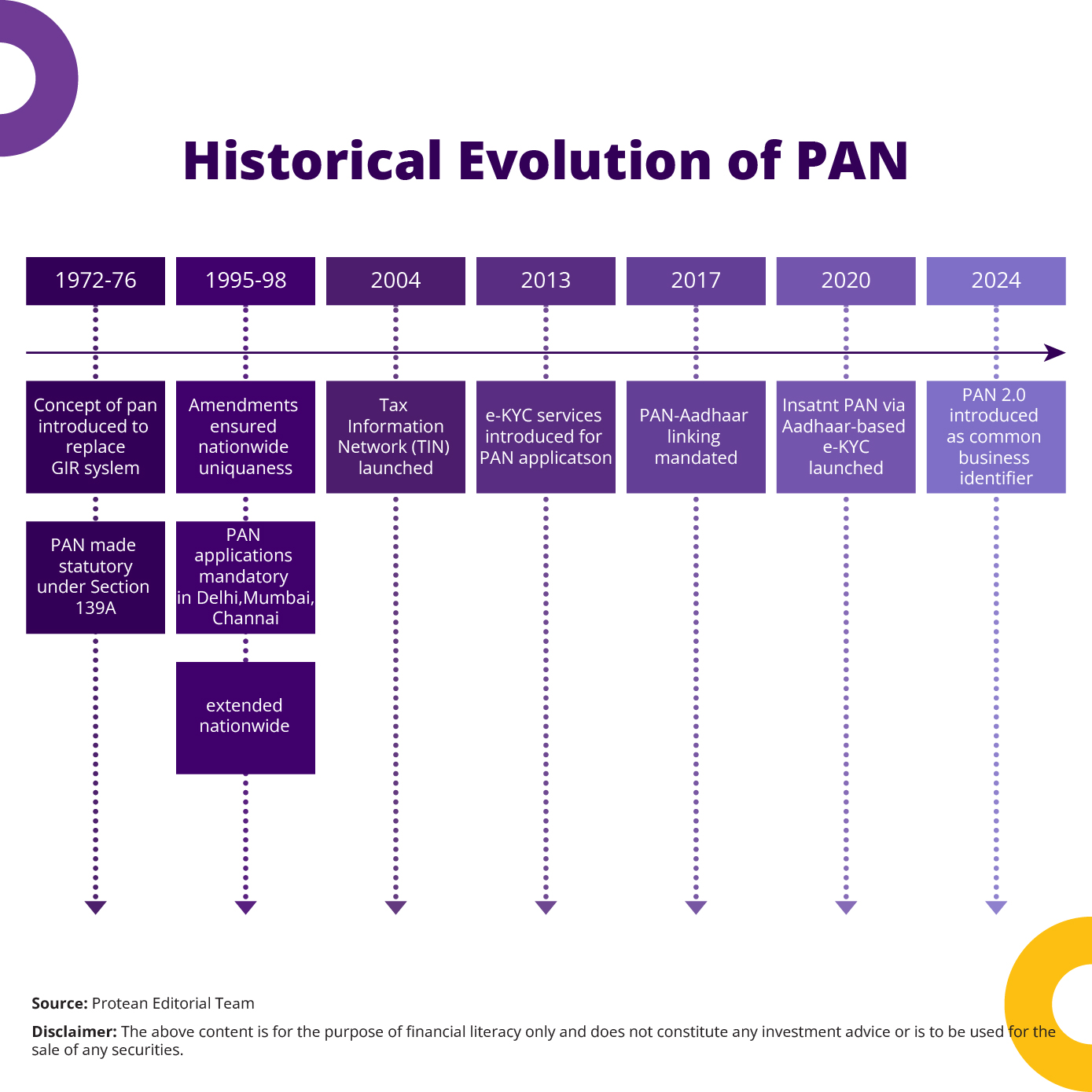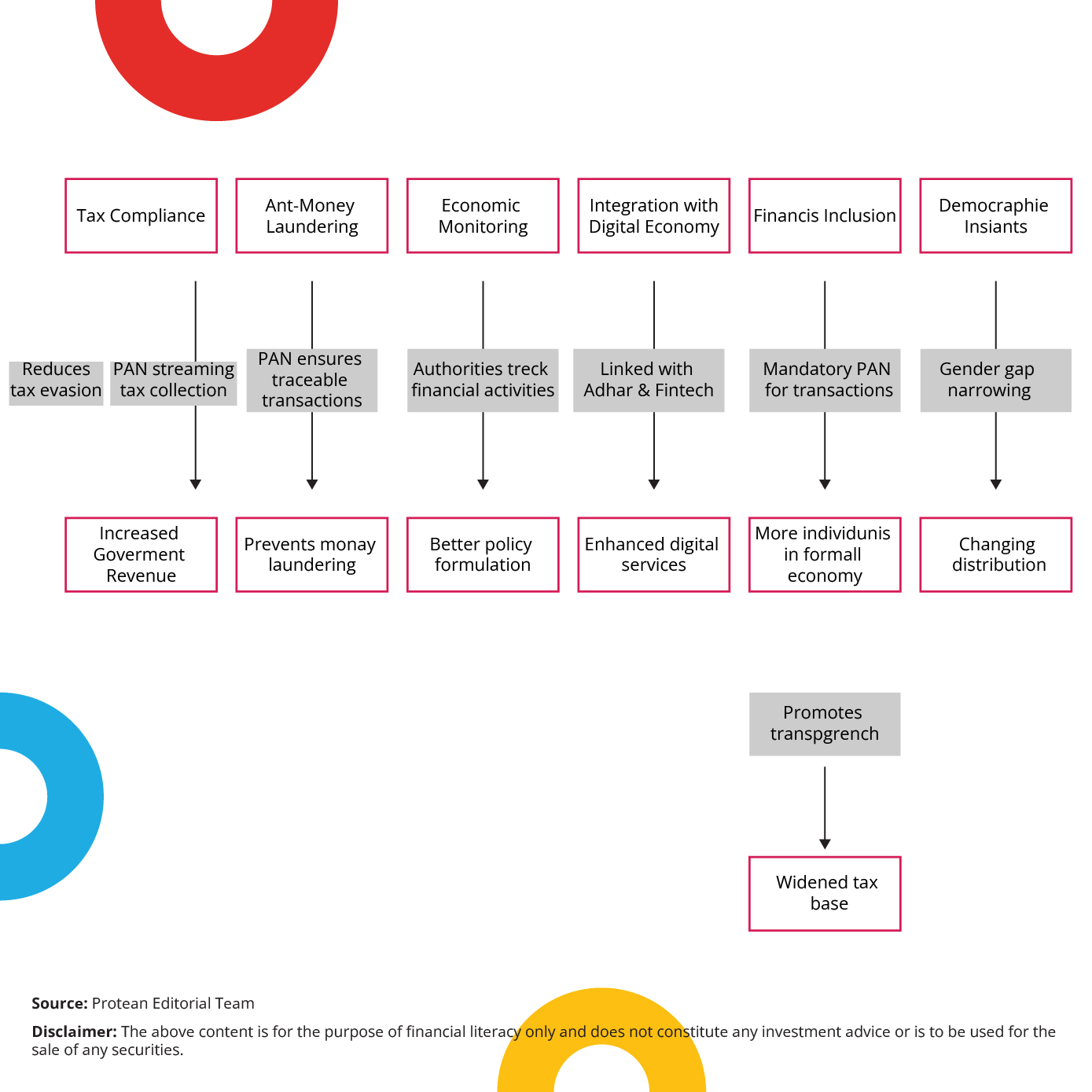The Permanent Account Number (PAN) has been a pivotal element in India's financial and taxation landscape since its introduction. Initially designed to streamline taxpayer identification and enhance tax compliance, PAN has evolved significantly in its structure, application process, and role within the Indian economy. Over the years, its scope has expanded from merely serving as a tax identifier to becoming a crucial instrument in banking, securities, insurance, and retirement planning.
PAN has now become a key component in India's financial infrastructure, linking multiple regulatory systems and enhancing transparency. The integration of PAN with various financial and governance mechanisms has helped in widening the tax base, curbing black money circulation, and facilitating smoother financial transactions.
| Get your PAN now! Available for individuals, businesses and HUF! Register and apply for PAN with this link. |
Let us see how the PAN has evolved over the decades:
Historical Evolution of PAN
- 1972: The concept of PAN was introduced to address the limitations of the General Index Register (GIR) system, which was manual and lacked nationwide uniqueness. PAN was made statutory under Section 139A of the Income Tax Act, 1961, effective from April 1, 1976.
- 1995: Amendments to Section 139A enabled the allotment of PAN under a new series, ensuring uniqueness across India. Applications for PAN became mandatory in Delhi, Mumbai, and Chennai on June 1, 1996, and extended nationwide by February 11, 1998.
- 2004: The Tax Information Network (TIN) was launched, facilitating electronic submission of Tax Deducted at Source (TDS) returns and aiding in PAN issuance.
- 2013: The introduction of e-KYC services streamlined the PAN application process, allowing for electronic verification of identity.
- 2017: Linking of PAN with Aadhaar was mandated to improve tax compliance and eliminate duplicate PANs.
- 2020: Finance Minister Nirmala Sitharaman on May 28, 2020, launched the instant Permanent Account Number (PAN) facility, which uses Aadhaar number based e-KYC.
- 2024: A revamped permanent account number (PAN) 2.0 as a common business identifier for all activities as well as a robust system for individual taxpayers has been introduced.
| Did you know that the year 2024 was a hallmark year for PAN in India. Learn about all the PAN milestones in 2024 here. |

Evolution of PAN's Use Cases
Initially, PAN served primarily as a tool for tracking taxable entities and preventing tax evasion. Over time, its applications have broadened significantly across multiple financial domains, ensuring regulatory oversight and compliance.
1. Taxation
PAN is mandatory for filing income tax returns, enabling the Central Board of Direct Taxes (CBDT) to track taxable transactions and prevent tax evasion. It is required for high-value financial transactions, such as the purchase of immovable property exceeding ₹10 lakh, as per Income Tax Department guidelines. PAN is also essential for TDS deduction, ensuring proper tax collection at the source.
| Check PAN recognition in social media platforms here. |
2. Banking Sector
- Account Opening: While PAN is not mandatory for opening a bank account, it is required for certain transactions involving high-value transfers.
- High-Value Transactions: Banks require customers to provide their PAN for cash deposits exceeding ₹50,000, helping curb money laundering activities and ensuring compliance with Anti Money Laundering (AML) laws.
- Fixed and Recurring Deposits: PAN is needed for fixed or recurring deposit accounts where interest earnings exceed a certain threshold, ensuring proper TDS deductions and tax compliance.
- Loan Processing: PAN is required for processing loans above a certain amount, ensuring borrower credibility and preventing fraudulent lending practices.
| 2024 has been a hallmark year for Protean, witnessing significant achievements across its verticals, from financial services to agriculture, health, and digital commerce. You can learn more about this update here. |
3. Insurance Sector
- Policy Purchases: PAN is required for purchasing life insurance policies where annual premiums exceed ₹50,000.
- Claim Settlements: Insurance providers may request PAN during claim settlements, particularly for significant amounts, to prevent fraudulent claims and ensure regulatory compliance.
- Tax Benefits: PAN allows insurers to report policyholder details to tax authorities, facilitating tax benefits under Sections 80C and 80D of the Income Tax Act.
Ready to secure your future? Open an NPS account today to enjoy tax benefits and build your retirement corpus.
4. National Pension System (NPS) & Retirement Planning
- Account Opening: PAN is required to enroll in the NPS as part of the Know Your Customer (KYC) process.
- Contribution Tracking: PAN facilitates efficient tracking of contributions, ensuring accurate record-keeping and transparency in retirement fund management.
- Withdrawal & Tax Benefits: PAN-linked pension accounts can ensure systematic withdrawal and taxation, enabling transparency in post-retirement financial planning. .
| For the application of e-PAN, follow these steps. If you wish to surrender a duplicate PAN, you may refer to this |
5. Securities Markets
- Demat Account Opening: Investors must furnish PAN when opening a Demat account to hold and trade securities electronically.
- Mutual Fund Investments: PAN is mandatory for investing in mutual funds, promoting transparency and aiding in the prevention of money laundering.
- Stock Market Transactions: For trading in equities and derivatives, stock exchanges mandate the submission of PAN to maintain a comprehensive record of all market participants and their transactions.
- Regulatory Compliance: SEBI mandates PAN for all financial transactions in capital markets to ensure investor identification and curb fraudulent activities.
Ensure your Aadhaar is linked to your NPS account for seamless and secure access. Visit your CRA portal today.
Role of PAN in the Indian Economy
PAN has become integral to India's economic framework, serving as a major enabler for transparency, financial inclusion, and regulatory compliance among others. Please check this image image below for details:

- Tax Compliance: PAN streamlines tax collection and reduces evasion, contributing to increased government revenues under the guidelines of the Income Tax Act, 1961.
| You can have a PAN even if you are an NRI or a Foreigner. For an online application, click here. |
- Anti-Money Laundering: PAN plays a crucial role in preventing money laundering by ensuring that all financial transactions are recorded and traceable.
- Economic Monitoring: PAN enables authorities to monitor financial activities effectively, aiding in policy formulation and economic planning.
- Integration with Digital Economy: With increased digital adoption, PAN is now integrated with Aadhaar and various fintech platforms, enhancing digital financial services.
- Financial Inclusion and Demographic Insights: Mandatory PAN requirements for financial transactions have brought more individuals and entities into the formal economy, promoting transparency and widening the tax base. As per the Business Standard’s report (Nov 2024), 780 million PAN cards have been issued, covering approximately 54 per cent of the population. The report has also indicated that 98 per cent of PAN holders are individuals, with male holders still outnumbering female holders. However, the gender gap is steadily narrowing. For instance, 65.37 per cent of PAN card holders were men, while 34.63 per cent were women in 2019, and by the year 2024, the distribution had shifted to 57.55 per cent men and 42.46 per cent women.
| For a quick guide on PAN information and services, you can visit this link |
Conclusion
Since its inception, PAN has evolved from a basic taxpayer identification tool to a multifaceted instrument central to India's financial and economic systems. Its expanding applications reflect the country's progression towards a more transparent and digitally integrated economy. The government’s continuous efforts to integrate PAN with regulatory mechanisms ensure compliance, financial discipline, and better tax administration. As digital transactions become more prevalent, PAN’s role will further strengthen, cementing its status as a cornerstone of India’s financial architecture.
Also read:
Learn all about PAN in 24 Questions
Is there a PAN for HUF? Learn all about HUF for PAN here
Discover the role of PAN in your tax saving! Save tax with PAN now!
PAN 2024 Developments: Being Adaptable, User-Friendly and Efficient
Here is how you can boost tax saving and wealth creation with NPS investing
NPS as a Smarter way to save with Seedha and Sayaani
Story by Bruhadeeswaran R.
Bruhadeeswaran has 15+ years of experience as a content strategist, communication, and editorial professional. Currently, he is leading an innovative content development process, translating complex B2B products into engaging, user-friendly narratives.

